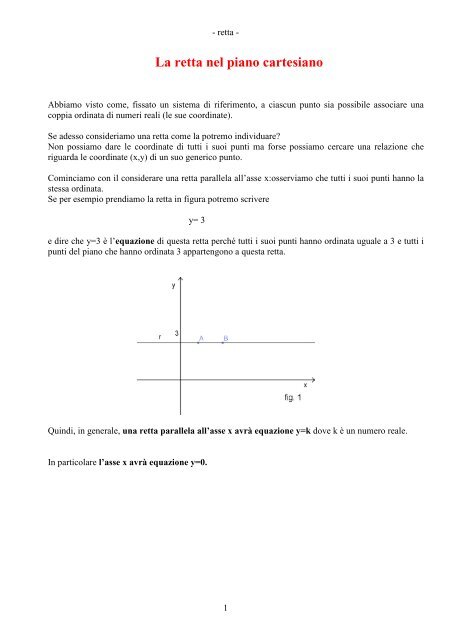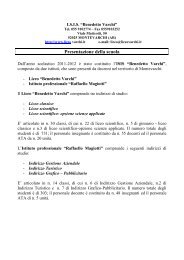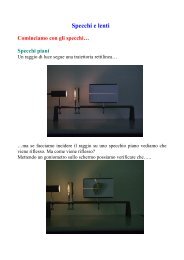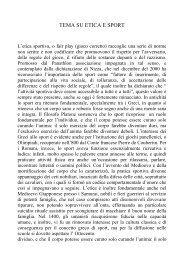La retta nel piano cartesiano - Liceo Varchi
La retta nel piano cartesiano - Liceo Varchi
La retta nel piano cartesiano - Liceo Varchi
Create successful ePaper yourself
Turn your PDF publications into a flip-book with our unique Google optimized e-Paper software.
- <strong>retta</strong> -<br />
<strong>La</strong> <strong>retta</strong> <strong>nel</strong> <strong>piano</strong> <strong>cartesiano</strong><br />
Abbiamo visto come, fissato un sistema di riferimento, a ciascun punto sia possibile associare una<br />
coppia ordinata di numeri reali (le sue coordinate).<br />
Se adesso consideriamo una <strong>retta</strong> come la potremo individuare?<br />
Non possiamo dare le coordinate di tutti i suoi punti ma forse possiamo cercare una relazione che<br />
riguarda le coordinate (x,y) di un suo generico punto.<br />
Cominciamo con il considerare una <strong>retta</strong> parallela all’asse x:osserviamo che tutti i suoi punti hanno la<br />
stessa ordinata.<br />
Se per esempio prendiamo la <strong>retta</strong> in figura potremo scrivere<br />
y= 3<br />
e dire che y=3 è l’equazione di questa <strong>retta</strong> perché tutti i suoi punti hanno ordinata uguale a 3 e tutti i<br />
punti del <strong>piano</strong> che hanno ordinata 3 appartengono a questa <strong>retta</strong>.<br />
Quindi, in generale, una <strong>retta</strong> parallela all’asse x avrà equazione y=k dove k è un numero reale.<br />
In particolare l’asse x avrà equazione y=0.<br />
1
- <strong>retta</strong> -<br />
Analogamente se consideriamo una <strong>retta</strong> parallela all’assey (vedi figura) osserviamo che tutti i suoi<br />
punti hanno la stessa ascissa , <strong>nel</strong> nostro caso 4, equindi l’equazione che descrive la <strong>retta</strong> sarà x=4.<br />
In generale una <strong>retta</strong> parallela all’assey avrà equazione x=k e in particolare l’asse y avrà<br />
equazione x=0.<br />
Consideriamo adesso una <strong>retta</strong> passante per l’origine degli assi (vedi figura): se P e Q sono due punti<br />
appartenenti alla <strong>retta</strong>, per la similitudine dei triangoli in figura OPP’ e OQQ’ potremo scrivere<br />
PP ' QQ'<br />
y y P Q<br />
= cioè = = 2<br />
OP'<br />
OQ'<br />
x x<br />
P<br />
y<br />
e quindi in generale potremo dire che l’equazione della <strong>retta</strong> è <strong>nel</strong> nostro esempio = 2 che<br />
x<br />
possiamo scrivere y=2x.<br />
In generale per una <strong>retta</strong> passante per l’origine potremo considerare i triangoli in figura OPP’ e OQQ’<br />
e potremo scrivere<br />
PP ' QQ'<br />
y y P Q<br />
= = m cioè =<br />
= m<br />
OP'<br />
OQ'<br />
x x<br />
P<br />
2<br />
Q<br />
Q
- <strong>retta</strong> -<br />
Quindi l’equazione di una <strong>retta</strong> per l’origine sarà :<br />
y = mx<br />
m viene detto coefficiente angolare della <strong>retta</strong> ed indica l’inclinazione della <strong>retta</strong>.<br />
Osserviamo che se m>0 la <strong>retta</strong> appartiene al I –III quadrante ( infatti le coordinate dei punti sono<br />
entrambe positive o negative e quindi il rapporto è un numero positivo) mentre se m
- <strong>retta</strong> -<br />
Consideriamo infine una <strong>retta</strong> non passante per l’origine O(0,0) e non parallela agli assi (vedi figura).<br />
Consideriamo il punto Q(0;q) in cui interseca l’asse y ed esprimiamo il coefficiente angolare m<br />
considerando un punto generico P ( x;<br />
y)<br />
e il punto Q.<br />
Abbiamo:<br />
y − q<br />
m = ⇒ y − q = m ⋅ x ⇒ y = m ⋅ x + q<br />
x<br />
Nell’equazione q viene detta ordinata all’origine poiché corrisponde all’ordinata del punto della <strong>retta</strong><br />
avente ascissa nulla.<br />
In figura 7 per esempio è stata rappresentata la <strong>retta</strong> di equazione y = 2x +3.<br />
4
- <strong>retta</strong> -<br />
Problema: è possibile scrivere un’equazione che riesca a rappresentare qualsiasi <strong>retta</strong> ?<br />
Abbiamo già fatto notare che all’asse y non poteva essere associato un coefficiente angolare e lo stesso<br />
vale per le rette parallele all’assey: l’equazione y = mx +q non riesce quindi a rappresentare tutte le<br />
rette del <strong>piano</strong> <strong>cartesiano</strong>.<br />
Osserviamo invece la seguente equazione:<br />
Proviamo a far variare i parametri a, b, c:<br />
ax +by +c = 0<br />
c<br />
se a = 0 e b ≠ 0 possiamo ricavare y = - e quindi otteniamo le rette parallele all’assex (per c = 0<br />
b<br />
abbiamo proprio l’asse x);<br />
c<br />
se a ≠ 0 e b = 0 possiamo ricavare x = - e quindi otteniamo le rette parallele all’asse y (per c = 0<br />
a<br />
abbiamo proprio l’assey);<br />
a<br />
se a ≠ 0 e b ≠ 0 ma c = 0 otteniamo y = - x cioè le rette per l’origine;<br />
b<br />
a c<br />
e infine se a ≠ 0 , b ≠ 0 e c ≠ 0 otteniamo y = - x - cioè le rette del tipo y = mx +q.<br />
b b<br />
Quindi l’equazione<br />
ax + by +c = 0<br />
rappresenta tutte le rette <strong>nel</strong> <strong>piano</strong> <strong>cartesiano</strong> e per questo viene detta equazione generale di una <strong>retta</strong>.<br />
5
- <strong>retta</strong> -<br />
Rette parallele<br />
Per quello che abbiamo detto è chiaro che due rette, non parallele all’asse y, sono parallele quando<br />
hanno lo stesso coefficiente angolare.<br />
Vediamo in figura le rette di equazione y = 2x e y = 2x +3.<br />
Rette perpendicolari<br />
Consideriamo una <strong>retta</strong> per l’origine r di equazione y = mx e costruiamo il triangolo OAD come in<br />
figura prendendo cioè OD = 1 e AD = m .<br />
A questo punto disegniamo il triangolo OCB prendendo BC = 1 e OB = m (vedi figura) e tracciamo la<br />
1<br />
<strong>retta</strong> s che avrà quindi equazione y = − x .<br />
m<br />
6
- <strong>retta</strong> -<br />
Poiché i triangoli OAD e OCB sono uguali per costruzione, avranno tutti gli angoli uguali e in<br />
∧<br />
∧<br />
particolare AOD = BCO = α e allora essendo BOC = 90°<br />
−α<br />
avremo che l’angolo AOC = 90°<br />
cioè<br />
le rette r e s sono perpendicolari.<br />
7<br />
∧<br />
<strong>La</strong> relazione che abbiamo trovato tra i coefficienti angolari di due rette perpendicolari passanti per<br />
l’origine vale naturalmente anche per rette perpendicolari non passanti per l’origine poiché quello che<br />
conta è il coefficiente angolare.<br />
Quindi possiamo dire che se una <strong>retta</strong> ha coefficiente angolare m , una <strong>retta</strong> con coefficiente angolare<br />
1<br />
− risulta ad essa perpendicolare (e viceversa se due rette sono perpendicolari e non parallele agli<br />
m<br />
assi i loro coefficienti angolari sono uno l’antireciproco dell’altro).<br />
1<br />
Vediamo per esempio in figura le rette perpendicolari di equazione y = 2x e y = - x +3.<br />
2<br />
∧
- <strong>retta</strong> -<br />
Intersezione tra due rette<br />
Supponiamo di avere due rette non parallele, per esempio y = 2x<br />
e y = −x<br />
+ 3 come in figura e di<br />
voler trovare le coordinate del loro punto P di intersezione.<br />
In questo caso le coordinate si possono determinare facilmente anche osservando la figura: P ( 1;<br />
2)<br />
.<br />
Ma in generale come possiamo trovarle?<br />
Poiché P ∈ r le sue coordinate devono verificare l’equazione di r .<br />
Poiché P ∈ s le sue coordinate devono verificare l’equazione di s .<br />
Quindi le coordinate ( x ; y)<br />
del punto di intersezione devono verificare entrambe le equazioni cioè<br />
sono la soluzione del sistema<br />
Infatti risolvendo abbiamo:<br />
⎧y<br />
= 2x<br />
⎨<br />
⎩2x<br />
= −x<br />
+ 3<br />
⇒<br />
⎧y<br />
= 2x<br />
⎨<br />
⎩y<br />
= −x<br />
+ 3<br />
⎧y<br />
= 2x<br />
⎨<br />
⎩3x<br />
= 3<br />
8<br />
⇒<br />
⎧y<br />
= 2<br />
⎨<br />
⎩x<br />
= 1<br />
In generale quindi per trovare le coordinate del punto di intersezione di due rette basterà risolvere il<br />
sistema formato dalle loro equazioni.<br />
Nota: se le rette sono parallele il sistema non avrà soluzione.
- <strong>retta</strong> -<br />
Equazione di una <strong>retta</strong> passante per un punto assegnato P ( xo<br />
; yo<br />
)<br />
ed avente un coefficiente angolare assegnato m<br />
Supponiamo di voler trovare l’equazione della <strong>retta</strong> passante per P ( 1;<br />
2)<br />
e avente coefficiente angolare<br />
m = 3 .<br />
Se trasliamo il sistema di riferimento portando l’origine <strong>nel</strong> punto P ( 1;<br />
2)<br />
avremo<br />
⎧x'<br />
= x −1<br />
⎨<br />
⎩y'<br />
= y − 2<br />
Ma <strong>nel</strong> nuovo sistema di riferimento sappiamo che l’equazione di r sarà<br />
e quindi, tornando a x e y , otteniamo<br />
y '= 3x'<br />
y − 2 = 3(<br />
x −1)<br />
In generale, quindi, la <strong>retta</strong> passante per ( o; o ) y x P con coefficiente angolare m avrà equazione:<br />
y −<br />
yo<br />
= m ⋅ ( x − xo<br />
)<br />
9
- <strong>retta</strong> -<br />
Equazione della <strong>retta</strong> passante per due punti assegnati<br />
Supponiamo di volere trovare l’equazione della <strong>retta</strong> passante per A ( 2;<br />
3)<br />
e B ( 6;<br />
5)<br />
.<br />
Osserviamo che possiamo ricavare il coefficiente angolare della <strong>retta</strong> partendo dal triangolo<br />
tratteggiato in figura:<br />
yB<br />
− y A<br />
m =<br />
x − x<br />
10<br />
B<br />
1<br />
e <strong>nel</strong> nostro esempio m = .<br />
2<br />
A questo punto possiamo utilizzare l’equazione della <strong>retta</strong> per A, per esempio, con coefficiente<br />
1<br />
1<br />
angolare m = : y − 3 = ( x − 2)<br />
2<br />
2<br />
In generale l’equazione della <strong>retta</strong> passante per A ( x A; y A ) e B ( xB<br />
; yB<br />
) avrà equazione:<br />
che può essere anche scritta<br />
y − y<br />
y − y<br />
B<br />
y B − y A<br />
y − y A = ⋅ ( x − x A )<br />
x − x<br />
A<br />
A<br />
x − x A<br />
= .<br />
x − x<br />
B<br />
A<br />
B<br />
Nota: se per ricavare m ci si affida al <strong>piano</strong> quad<strong>retta</strong>to occorre fare attenzione ai coefficienti angolari<br />
negativi.<br />
Per esempio le misure dei cateti del triangolo<br />
tratteggiato sono ancora 2 e 4 ma in questo caso è chiaro<br />
1<br />
che m = − .<br />
A<br />
A<br />
2<br />
y<br />
Infatti m<br />
=<br />
x<br />
B<br />
B<br />
−<br />
−<br />
y<br />
x<br />
A<br />
A<br />
4 − 2 1<br />
= = −<br />
− 5 + 1 2
Problema<br />
- <strong>retta</strong> -<br />
A questo punto si possono già risolvere molti problemi collegati con la <strong>retta</strong>. Vediamone uno.<br />
Δ<br />
Dati tre punti A ( 5;<br />
1)<br />
B (−3;<br />
5)<br />
C ( 0;<br />
−4)<br />
considera il triangolo ABC e determina le coordinate del<br />
circocentro K (centro della circonferenza circoscritta ≡ intersezione degli assi dei lati del triangolo ) e<br />
dell’ortocentro H (intersezione delle altezze).<br />
Ricerca del circocentro K<br />
Dobbiamo intersecare due assi del triangolo, per esempio K<br />
11<br />
⎧asse<br />
⎨<br />
⎩asse<br />
Poiché l’asse di un segmento è la <strong>retta</strong> perpendicolare al segmento passante per il suo punto medio,<br />
dobbiamo trovare<br />
M AB ( 1;<br />
3)<br />
1<br />
m AB = − ⇒<br />
2<br />
m asseAB = 2<br />
5 3<br />
M AC ( ; − )<br />
2 2<br />
m AC = 1 ⇒ m asseAC = −1<br />
Avremo quindi:<br />
K<br />
⎧y<br />
− 3 = 2(<br />
x −1)<br />
⎪<br />
⎨ 3 5<br />
⎪y<br />
+ = −(<br />
x − )<br />
⎩ 2 2<br />
⇒<br />
⎧y<br />
= 2x<br />
+ 1<br />
⎨<br />
⎩y<br />
= −x<br />
+ 1<br />
⇒<br />
AB<br />
AC<br />
⎧2x<br />
+ 1 = −x<br />
+ 1<br />
⎨<br />
⎩y<br />
= −x<br />
+ 1<br />
⇒<br />
⎧x<br />
= 0<br />
⎨<br />
⎩y<br />
= 1
Ricerca dell’ortocentro H<br />
Dobbiamo intersecare due altezze, per esempio<br />
Quindi avremo:<br />
H<br />
H<br />
⎧y<br />
− 5 = −(<br />
x + 3)<br />
⎨<br />
⇒<br />
⎩y<br />
+ 4 = 2x<br />
B<br />
⎧h<br />
⎨<br />
⎩h<br />
B<br />
C<br />
- <strong>retta</strong> -<br />
altezza uscente da B<br />
altezza uscente da C<br />
h : m 1 ⇒ m = −1<br />
AC<br />
12<br />
= hB<br />
1<br />
h C : m AB = − ⇒ mhC<br />
= 2<br />
2<br />
⎧y<br />
= −x<br />
+ 2<br />
⎨ ⇒<br />
⎩y<br />
= 2x<br />
− 4<br />
⎧−<br />
x + 2 = 2x<br />
− 4<br />
⎨<br />
⎩y<br />
= 2x<br />
− 4<br />
⇒<br />
⎧x<br />
= 2<br />
⎨<br />
⎩y<br />
= 0
Distanza di un punto P da una <strong>retta</strong> r<br />
- <strong>retta</strong> -<br />
In molti casi è utile conoscere la distanza di un punto P da una <strong>retta</strong> r.<br />
Potremo tracciare la <strong>retta</strong> per P perpendicolare ad r, trovare il punto H di intersezione con r e poi<br />
calcolare la distanza HP . Questo procedimento risulta piuttosto lungo.<br />
Vogliamo dimostrare che se<br />
r : ax + by + c = 0 ( o; o ) y x P<br />
d(<br />
P,<br />
r)<br />
=<br />
1. Cominciamo con il considerare P ( 0;<br />
0)<br />
Consideriamo il triangolo<br />
si ottiene<br />
13<br />
ax<br />
o<br />
+ by<br />
a<br />
2<br />
o<br />
+ b<br />
+ c<br />
2<br />
r : ax + by + c = 0<br />
c<br />
A( 0;<br />
− )<br />
b<br />
c<br />
B( − ; 0)<br />
a<br />
Δ<br />
APB : PH è l’altezza relativa all’ipotenusa e quindi poiché<br />
c<br />
b<br />
c<br />
a<br />
c ( a + b<br />
a b<br />
2 2 2 2 2<br />
AB = + 2 2 =<br />
2 2 =<br />
2<br />
a +<br />
PH<br />
PA⋅<br />
PB<br />
= =<br />
AB<br />
c<br />
ab<br />
c<br />
b<br />
⋅<br />
⋅<br />
a<br />
c<br />
a<br />
)<br />
c<br />
ab<br />
c<br />
2 2<br />
2 2 a b<br />
2. Se P ≠ ( 0;<br />
0)<br />
possiamo traslare il sistema di riferimento portando l’origine in P.<br />
+ b<br />
=<br />
+<br />
b<br />
2
Sappiamo che<br />
⎧x'<br />
= x − xo<br />
⎨<br />
⎩y'<br />
= y − y<br />
o<br />
⇒<br />
- <strong>retta</strong> -<br />
⎧x<br />
= x'+<br />
xo<br />
⎨<br />
⎩y<br />
= y'+<br />
y<br />
L’equazione della <strong>retta</strong> r <strong>nel</strong> nuovo sistema di riferimento sarà quindi:<br />
a o<br />
o<br />
o<br />
( x'+<br />
x ) + b(<br />
y'+<br />
y ) + c = 0<br />
ax o o<br />
' + by'+<br />
ax + by + c = 0<br />
Poiché il termine noto è axo + byo<br />
+ c e, <strong>nel</strong> nuovo sistema di riferimento P coincide con l’origine,<br />
utilizzando la formula trovata precedentemente avremo:<br />
ax<br />
d(<br />
P,<br />
r)<br />
=<br />
Problema: calcolo dell’area di un triangolo<br />
Determina l’area del triangolo<br />
Δ<br />
ABC in figura.<br />
14<br />
o<br />
+ by<br />
a<br />
2<br />
o<br />
+ b<br />
Δ 1<br />
Possiamo calcolare area( ABC)<br />
= AB ⋅ d(<br />
C,<br />
rAB<br />
)<br />
2<br />
AB =<br />
r AB :<br />
16 + 4 = 20 = 2<br />
1 1<br />
m = y − 2 = ( x −1)<br />
⇒<br />
2 2<br />
6 − 2 ⋅1<br />
+ 3<br />
d ( C,<br />
rAB<br />
) =<br />
=<br />
1+<br />
4<br />
7<br />
5<br />
Δ 1<br />
Quindi: area<br />
( ABC)<br />
= ⋅ 2<br />
2<br />
5 ⋅<br />
7<br />
= 7<br />
5<br />
5<br />
+ c<br />
2<br />
A(<br />
1;<br />
2)<br />
B(<br />
5;<br />
4)<br />
C(<br />
6;<br />
1)<br />
1 3<br />
y = x + ⇒ x − 2 y + 3 = 0<br />
2 2
- <strong>retta</strong> -<br />
Equazioni delle bisettrici degli angoli individuati da due rette<br />
Supponiamo di dover risolvere il seguente problema: date le rette di equazione r : y = 2x<br />
1<br />
s : y = − x , determinare le equazioni delle bisettrici degli angoli individuati da esse.<br />
2<br />
15<br />
r : y = 2x<br />
1<br />
s : y = − x<br />
2<br />
Ricordiamo che se P ( x;<br />
y)<br />
appartiene ad una bisettrice dovrà essere d ( P,<br />
r)<br />
= d(<br />
P,<br />
s)<br />
.<br />
Quindi , scrivendo<br />
E quindi possiamo avere due casi:<br />
r : 2x<br />
− y = 0<br />
s : x + 2y<br />
= 0<br />
dovrà essere<br />
2x − y x + 2y<br />
=<br />
5 5<br />
1<br />
2 x − y = x + 2y<br />
⇒ x − 3y<br />
= 0 ⇒ y = x ( b 1)<br />
3<br />
2x − y = −(<br />
x + 2y)<br />
⇒ 3x<br />
+ y = 0 ⇒ y = −3x<br />
b )<br />
Osserviamo che le due bisettrici sono tra loro perpendicolari. Infatti osservando la figura è chiaro che<br />
( 2<br />
2α + 2β<br />
= 180°<br />
e quindi<br />
α<br />
+ β = 90°
1. Disegna le rette aventi le seguenti equazioni:<br />
- <strong>retta</strong> -<br />
Problemi sulla <strong>retta</strong><br />
a) y=3x<br />
2<br />
b) y = − x<br />
3<br />
1<br />
c) y = x<br />
4<br />
d) y=3x+1<br />
2<br />
e) y = − x + 3<br />
3<br />
1<br />
f) y = x − 2<br />
4<br />
2. Disegna le rette aventi le seguenti equazioni:<br />
a) 2x+y=0 b) 3x-y=0 c) x-2y+2=0<br />
d) 2x-y+1=0 e) 2x-4=0 f) 5y-15=0<br />
1 1<br />
3. Date le rette di equazione y=2x , y = − x + 5 , y = x determina perimetro e area del triangolo<br />
2<br />
3<br />
individuato dalle rette e verifica che si tratta di un triangolo <strong>retta</strong>ngolo isoscele.<br />
16<br />
[ 2 p = 4 5 + 2 10 ; A = 10 ]<br />
4. Dati i punti A(1;3) B(3;7) C(7;-1) determina le equazioni delle rette passanti per A,B per B,C ,per<br />
A,C. Calcola il perimetro del triangolo. Determina le coordinate del baricentro G e dell’ortocentro H<br />
del triangolo.<br />
2 11<br />
11 5<br />
[y=2x+1;y=-2x+13; y = − x + ; 2 p = 2 5 + 2 13 + 4 5 ; G ( ; 3)<br />
; H ( 0;<br />
) ]<br />
3 3<br />
3 2<br />
5. Considera i punti A(2;2) B(4;6) C(8;4).Determina le equazioni delle rette dei lati e verifica che si<br />
tratta di un triangolo <strong>retta</strong>ngolo isoscele. Determina perimetro e area. Determina le coordinate di<br />
baricentro, ortocentro e circocentro e verifica che sono allineati.<br />
1 1 4<br />
14<br />
[y=2x-2 ; y = − x + 8 ; y = x + ; 2 p = 4 5 + 2 10 ; A=10 ; G ( ; 4)<br />
; H(4;6); K(5;3) ]<br />
2 3 3<br />
3<br />
6. Considera i punti A(-3;0) B(3;2) C(5;-2). Determina le coordinate del circocentro K del triangolo<br />
ABC.<br />
6 11<br />
[ K ( ; − ) ]<br />
7 7
7. Dati i punti A(-2;1) B(2;5) C(5;-1) determina:<br />
- <strong>retta</strong> -<br />
a) l’equazione della <strong>retta</strong> per A e B, per B e C, per A e C;<br />
Δ<br />
b) il perimetro e l’area del triangolo ABC ;<br />
c) le coordinate del baricentro G e dell’ortocentro H del triangolo.<br />
2 3<br />
5 5 4 8<br />
[ y = x + 3 ; y = −2x<br />
+ 9;<br />
y = − x + ; 2 p = 4 2 + 3 5 + 53;<br />
A = 18 ; G ( ; ) ; H ( ; ) ]<br />
7 7<br />
3 3 3 3<br />
8. Dati i punti A(0;1) B(2;4) C(5;2) determina:<br />
a) l’equazione della <strong>retta</strong> per A e B, per B e C, per A e C;<br />
b) il perimetro e l’area del triangolo<br />
c) le coordinate del circocentro K del triangolo<br />
Δ<br />
ABC (verifica anche che è un triangolo <strong>retta</strong>ngolo);<br />
17<br />
Δ<br />
ABC .<br />
3 2 16 1<br />
13 5 3<br />
[ y = x + 1;<br />
y = − x + ; y = x + 1;<br />
2 p = 2 13 + 26;<br />
A = ; K(<br />
; ) ]<br />
2 3 3 5<br />
2 2 2<br />
9. Dati i punti A(0;4) B(2;6) C(5;5) D(1;1) determina:<br />
a) l’equazione della <strong>retta</strong> per A e B, per B e C, C e D, D e A;<br />
b) verifica che ABCD è un trapezio isoscele e determina perimetro e area.<br />
1 20<br />
[ y<br />
= x + 4 ; y = − x + ; y = x;<br />
y = −3x<br />
+ 4;<br />
2 p = 2 10 + 6 2;<br />
A = 12]<br />
3 3
10. Dati i punti A(0;3) B(2;7) C(6;5) D(4;1)<br />
- <strong>retta</strong> -<br />
a) l’equazione della <strong>retta</strong> per A e B, per B e C, C e D, D e A;<br />
b) verifica che ABCD è un quadrato e calcolane perimetro e area;<br />
c) determina le coordinate del centro di simmetria O del quadrato ABCD.<br />
11. Dati i punti A(-2;3) B(1;6) C(4;0)<br />
1<br />
1<br />
[ y = 2x + 3;<br />
y = − x + 8;<br />
y = 2x<br />
− 7;<br />
y = − x + 3;<br />
2 p = 8 5;<br />
A = 20;<br />
O(<br />
3;<br />
4)]<br />
2<br />
2<br />
a) l’equazione della <strong>retta</strong> per A e B, per B e C, per A e C;<br />
b) determina le coordinate del baricentro G, dell’ortocentro H e del circocentro K del triangolo<br />
Δ<br />
ABC e verifica che sono allineati.<br />
12. Date le rette di equazione<br />
r : y = 3x<br />
−1<br />
s : x + 3y<br />
−17<br />
= 0<br />
t : x − y −1<br />
= 0<br />
1<br />
3 5<br />
[ y = x + 5 ; y = −2x<br />
+ 8;<br />
y = − x + 2 G ( 1;<br />
3)<br />
H(0;4) K ( ; ) ]<br />
2<br />
2 2<br />
a) determina le coordinate dei punti di intersezione A ( r,<br />
s)<br />
B ( s,<br />
t)<br />
C ( r,<br />
t)<br />
;<br />
Δ<br />
b) verifica che ABC è un triangolo <strong>retta</strong>ngolo;<br />
Δ<br />
c) determina il perimetro e l’area del triangolo ABC .<br />
[ A(2;5) B(5;4) C(0;-1) 2 p<br />
= 3 10 + 5 2;<br />
A = 10]<br />
18
- <strong>retta</strong> -<br />
13. Calcola l’area del triangolo di vertici A(3;2) B(10;3) C(6;7).<br />
14. Calcola l’area del triangolo di vertici A(1;-2) B(3;-4) C(-1;3).<br />
15. Calcola l’area del triangolo di vertici A(-3;1) B(-2;-5) C(4;-1).<br />
16. Calcola la distanza d tra le rette di equazione y=2x e y=2x +3.<br />
17. Calcola la distanza d tra le rette di equazione x-y+1=0 e x-y-4=0.<br />
18. Calcola la distanza d tra le rette di equazione 2x+y=0 e 2x+y-3=0.<br />
19<br />
[A=16]<br />
[A=3]<br />
[A=20]<br />
3<br />
[ d = ]<br />
5<br />
5<br />
[d= ]<br />
2<br />
3<br />
[ d = ]<br />
5<br />
19. a) Considera i punti A(-4;1) B(1;6) C(4;-3) . Determina le equazioni delle rette r AB (<strong>retta</strong> passante<br />
per i punti A e B ), r AC (<strong>retta</strong> passante per i punti A e C ) e r BC (<strong>retta</strong> passante per i punti B e C).<br />
b) Determina perimetro e area del triangolo ABC.<br />
c) Determina le coordinate dell’ortocentro H.<br />
d) Determina le coordinate del circocentro K.<br />
e) Determina le coordinate del baricentro G e verifica che H, K e G sono allineati.<br />
1 4<br />
[ rAB : y = x + 5;<br />
rBC<br />
: y = −3x<br />
+ 9;<br />
rAC<br />
: x + 2y<br />
+ 2 = 0;<br />
H ( −1;<br />
2);<br />
K(<br />
1;<br />
1);<br />
G(<br />
; )]<br />
3 3<br />
20. a) Considera le rette r 1 ; x + 2y<br />
−12<br />
= 0 r 2 : 2x<br />
+ y −12<br />
= 0 e<br />
1<br />
r 3 : y = − x + 3 . Disegnale e<br />
2<br />
determina le coordinate di A ( r1<br />
, assey)<br />
, ) r B e ) , r C .<br />
( 1 2 r<br />
( 2 3 r<br />
b) Determina l’equazione della <strong>retta</strong> r 4 parallela alla <strong>retta</strong> r 2 e passante per A e indica con D<br />
l’intersezione tra r 3 e r 4 . Come risulta il quadrilatero ABCD ?<br />
c) Determina perimetro e area di ABCD.<br />
[ A(0;6) B(4;4) C(6;0) r : y = −2x<br />
+ 6 ; D(2;2) ABCD è un rombo; 2 p = 8 5 Area=12]<br />
4
- <strong>retta</strong> -<br />
Fasci di rette<br />
Per fascio di rette si intende o l’insieme di tutte le rette parallele ad una <strong>retta</strong> data oppure l’insieme di<br />
tutte le rette passanti per un punto dato.<br />
Per esempio, per indicare il fascio di rette parallele alla <strong>retta</strong> y = 2x<br />
scriverò:<br />
y = 2 x + k ( k è detto parametro)<br />
Al variare di k (che rappresenta in questo caso l’ordinata all’origine) ottengo tutte le rette del fascio.<br />
Per indicare, per esempio, il fascio di rette passanti per il punto P(1;2) scriverò:<br />
y − 2 = k(<br />
x −1)<br />
∪ x = 1<br />
In questo caso k rappresenta il coefficiente angolare. <strong>La</strong> <strong>retta</strong> x = 1 deve essere indicata a parte<br />
poiché non si ottiene per nessun valore di k .<br />
a) Consideriamo le due rette in figura<br />
Fascio individuato da due rette “generatrici”<br />
20<br />
r : y = 2x<br />
⇒ 2x<br />
− y = 0<br />
s : y = −x<br />
+ 6 ⇒ x + y − 6 = 0 .
- <strong>retta</strong> -<br />
Per indicare il fascio di rette “generato” da r e s , cioè l’insieme delle rette passanti per il loro punto<br />
di intersezione P(2;4) posso scrivere così:<br />
k ( 2x<br />
− y)<br />
+ x + y − 6 = 0<br />
Infatti si tratta, al variare di k, dell’equazione di una <strong>retta</strong> passante per P(2;4) poiché sostituendo x=2<br />
y=4 si annulla sia 2 x − y che x + y − 6 = 0 .<br />
Le rette r e s si chiamano “generatrici” del fascio.<br />
Si osserva facilmente che se k=0 si ottiene x + y − 6 = 0 cioè la <strong>retta</strong> s , ma per quale valore di k<br />
otteniamo la <strong>retta</strong> r ?<br />
Proviamo per esempio ad assegnare a k il valore 1: 2 x − y + x + y − 6 = 0 ⇒ 3x<br />
= 6 ⇒ x = 2<br />
Osserviamo che se assegniamo a k un valore grande in valore assoluto, per esempio k=100 o k=-100,<br />
troviamo delle rette molto vicine a r poiché è come se il termine ( x + y − 6)<br />
diventasse trascurabile.<br />
Per esempio:<br />
201 6<br />
k=100 ⇒ 201 x − 99y<br />
− 6 = 0 ⇒ y = x +<br />
99 99<br />
199 6<br />
k=-100 ⇒ −199<br />
x + 101y<br />
− 6 = 0 ⇒ y = x +<br />
101 101<br />
Si stabilisce quindi di associare a r il valore “infinito” (∞) di k .<br />
Quindi<br />
k = ∞ ⇒ 2x<br />
− y = 0<br />
k = 0 ⇒ x + y − 6 = 0<br />
Osserviamo infine che i valori di k , <strong>nel</strong> nostro esempio, aumentano quando si ruota in senso orario: se<br />
infatti vogliamo andare dalla <strong>retta</strong> corrispondente a k=0 a quella corrispondente a k=1, senza toccare la<br />
<strong>retta</strong> k = ∞ , dobbiamo ruotare in senso orario: quindi partendo da r e ruotando in senso orario si<br />
hanno valori da − ∞ a + ∞ .<br />
21
) Consideriamo le due rette in figura:<br />
Se considero l’equazione:<br />
- <strong>retta</strong> -<br />
22<br />
r : y = 2x<br />
⇒ 2x<br />
− y = 0<br />
s : y = 2x<br />
+ 3 ⇒ 2x<br />
− y + 3 = 0<br />
k ( 2x<br />
− y)<br />
+ 2x<br />
− y + 3 = 0 ⇒ 2 ( k + 1)<br />
x − ( k + 1)<br />
y + 3 = 0<br />
al variare di k (con k ≠ −1)<br />
ottengo rette parallele ad r e s .<br />
Si tratta quindi di un fascio di rette parallele (m=2) in cui<br />
k = 0 ⇒ s<br />
k = ∞ ⇒ r<br />
r e s sono le “generatrici” del fascio.<br />
Problema<br />
Considera il fascio k ( 2x<br />
− y)<br />
+ x + y − 6 = 0 .<br />
1. Determina per quale valore di k si ottiene la <strong>retta</strong> parallela all’asse x e per quale valore di k si<br />
ottiene la <strong>retta</strong> parallela all’asse y.<br />
Se sviluppiamo l’equazione data del fascio otteniamo ( 2k<br />
+ 1)<br />
x + ( 1 − k)<br />
y − 6 = 0 .<br />
Quindi avremo<br />
1<br />
una <strong>retta</strong> parallela all’asse x se 2k + 1 = 0 ⇒ k = −<br />
2<br />
una <strong>retta</strong> parallela all’asse y se 1 − k = 0 ⇒ k = 1<br />
2. Determina per quale valore di k si ottiene la <strong>retta</strong> passante per P(4;5).<br />
Basterà sostituire le coordinate del punto <strong>nel</strong>l’equazione del fascio:<br />
k ( 2 ⋅ 4 − 5)<br />
+ 4 + 5 − 6 = 0 ⇒ 3k<br />
+ 3 = 0 ⇒ k = −1<br />
3. Determina per quale valore di k si ottiene una <strong>retta</strong> parallela alla bisettrice del I-III quadrante.<br />
2k<br />
+ 1<br />
Poiché il coefficiente angolare delle rette del fascio risulta m = dovrà essere<br />
k −1<br />
2k<br />
+ 1<br />
= 1 ⇒ 2k<br />
+ 1 = k −1<br />
⇒ k = −2<br />
k −1
- <strong>retta</strong> -<br />
4. Determina per quali valori di k si ottengono rette che intersecano il segmento AB in figura.<br />
k A<br />
k B<br />
: k(<br />
2 ⋅ 2 − 2)<br />
+ 2 + 2 − 6 = 0 ⇒ 2k<br />
= 2 ⇒ k = 1<br />
: k(<br />
2 ⋅ 5 − 3)<br />
+ 5 + 3 − 6 = 0 ⇒ 7k<br />
= −2<br />
⇒ k = −<br />
2<br />
Quindi se − ≤ k ≤ 1 le rette intersecano il segmento.<br />
7<br />
23<br />
2<br />
7<br />
A(2;2)<br />
B(5;3)<br />
Nota<br />
Se il segmento AB interseca la <strong>retta</strong> generatrice corrispondente a k = ∞ occorre fare attenzione.<br />
Se per esempio A(2;2) B(0;3):<br />
k B : k(<br />
−3) + 3 − 6 = 0 ⇒ −3k<br />
= 3 ⇒ k = −1<br />
Le rette che intersecano il segmento AB si avranno, in questo caso, per k ≤ −1∪<br />
k ≥ 1 (osserva come<br />
aumentano i valori di k ).
- <strong>retta</strong> -<br />
Problemi sui fasci di rette<br />
1. Studia i fasci di rette aventi le seguenti equazioni:<br />
a) y = x + k ;<br />
1<br />
b) y = − x + k ;<br />
2<br />
c) y = mx + 2 ;<br />
d) y − 3 = m(<br />
x −1)<br />
Δ<br />
2. Considera il triangolo ABC con A(-4;1) B(-3;-1) C(-1;3). Nel fascio di rette parallele alla <strong>retta</strong> per<br />
B e C determina quella che stacca su ABC un triangolo A’B’C’ tale che<br />
Δ 1<br />
Δ<br />
area ( A'<br />
B'C<br />
')<br />
= area(<br />
ABC)<br />
.<br />
4<br />
[y=2x+7]<br />
3. Per quali valori di k le rette di equazione y=2x+k intersecano il triangolo<br />
precedente?<br />
24<br />
Δ<br />
ABC dell’esercizio<br />
[ 5 ≤ k ≤ 9]<br />
Δ<br />
4. Considera il triangolo ABC con A(-2;0) B(1;9) C(7;7). Determina perimetro e area. Calcola le<br />
coordinate del baricentro G, dell’ortocentro H e del circocentro K. Determina l’equazione della<br />
<strong>retta</strong> parallela alla <strong>retta</strong> per B e C che stacca un triangolo AB’C’ tale che<br />
Δ 1<br />
Δ<br />
area ( AB'C')<br />
= area(<br />
ABC)<br />
.<br />
9<br />
Δ<br />
16<br />
5 7 1 8<br />
[ 2 p = 5 10 + 130;<br />
A = 30;<br />
G(<br />
2;<br />
); H ( 1;<br />
9);<br />
K(<br />
; ); y = − x + ]<br />
3<br />
2 2 3 3<br />
5. Dato il triangolo ABC con A(1;3) B(3;7) C(7;-1) determina per quali valori di k le rette del fascio<br />
1<br />
Δ<br />
y = x + k intersecano il triangolo ABC .<br />
2<br />
9 11<br />
[ − ≤ k ≤ ]<br />
2 2
6. Considera il triangolo<br />
Δ<br />
- <strong>retta</strong> -<br />
ABC dell’esercizio precedente: per quale valore di k la <strong>retta</strong> del fascio<br />
y = −2<br />
x + k stacca un triangolo AB 'C'<br />
di area 4?<br />
7. Studia i fasci di rette aventi equazione:<br />
Δ<br />
25<br />
[k=9]<br />
a) ( k −1) x + ky + k + 3 = 0<br />
[C(3;-4)]<br />
b) ( k + 1)<br />
x − ( k −1)<br />
y − k − 3 = 0<br />
[C(2;1)]<br />
1 1<br />
c) 2 kx − ( k + 3)<br />
y − k −1<br />
= 0<br />
[ C ( ; − )]<br />
3 3<br />
d) ( 2k<br />
−1) x + ky + 3 = 0<br />
[C(3;-6)]<br />
e) ( 1+<br />
k ) x + ( 2 − k)<br />
y − 4 − k = 0<br />
[C(2;1)]<br />
f) ( 1−<br />
k ) x + ( 1+<br />
k)<br />
y − 2(<br />
k + 2)<br />
= 0<br />
[C(1;3)]<br />
g) ( 1+<br />
k ) x − ( 1+<br />
k)<br />
y + 2 = 0<br />
[rette parallele con m=1]<br />
8. Studia il fascio di rette di equazione<br />
e determina:<br />
( 2k<br />
−1) x + ky − 5 = 0<br />
a) il valore di k per cui si ha una <strong>retta</strong> parallela all’asse x;<br />
b) il valore di k per cui si ha una <strong>retta</strong> parallela all’asse y;<br />
c) il valore di k per cui si ha una <strong>retta</strong> parallela alla <strong>retta</strong> di equazione y=x;<br />
d) i valori di k per cui le rette del fascio intersecano il segmento AB con A(1;0) e B(3;2).<br />
1 1<br />
[ k = ; k = 0;<br />
k = ; 1 ≤ k ≤ 3 ]<br />
2 3
- <strong>retta</strong> -<br />
9. Studia il fascio di rette di equazione ( 2 + k ) x + ( k −1)<br />
y + 3 − k = 0 e determina:<br />
a) il valore di k per cui si ha una <strong>retta</strong> parallela alla <strong>retta</strong> di equazione y=-x;<br />
b) i valori di k per cui le rette del fascio intersecano il segmento AB con A(0;0) B(2;0);<br />
c) il valore di k per cui si ha una <strong>retta</strong> parallela all’asse x;<br />
d) il valore di k per cui si ha una <strong>retta</strong> parallela all’asse y.<br />
26<br />
2 5<br />
[ C ( − ; ); k = ∞;<br />
k ≤ −7<br />
∪ k ≥ 3;<br />
k = −2;<br />
k = 1]<br />
3 3<br />
10. Studia il fascio di rette di equazione k ( x − 2y<br />
+ 8)<br />
+ 3x<br />
+ y + 3 = 0 e determina per quali valori di<br />
k le rette del fascio intersecano il triangolo<br />
Δ<br />
ABC dove A(1;1) B(3;-2) e C(-1;-5).<br />
11. Studia il fascio di rette di equazione ( x − 2y)<br />
+ k(<br />
2x<br />
+ y + 1)<br />
= 0 e determina:<br />
a) per quali valori di k le rette del fascio intersecano il triangolo<br />
5<br />
[C(-2;3); −1 ≤ k ≤ ]<br />
17<br />
Δ<br />
ABC con A(0;0) B(2;2) C(4;-1);<br />
b) per quale valore di k si ha una <strong>retta</strong> perpendicolare alla <strong>retta</strong> di equazione y=x.<br />
12. Studia F : k ( x − 2y<br />
+ 2)<br />
+ 3x<br />
+ y − 8 = 0 e determina:<br />
2 1 3 2<br />
[ C ( − ; − ); − ≤ k ≤ ; k = −3]<br />
5 5 4 7<br />
a) per quali valori di k le rette del fascio intersecano il segmento AB con A(4;4) e B(6;2);<br />
b) per quale valore di k si ha una <strong>retta</strong> parallela alla <strong>retta</strong> di equazione y = −2x<br />
.<br />
1<br />
[C(2;2) ; k<br />
≤ −3<br />
∪ k ≥ 4;<br />
k = − ]<br />
5









